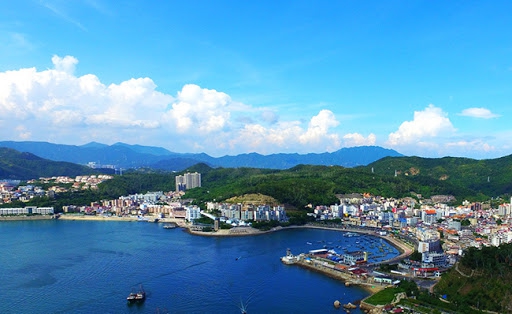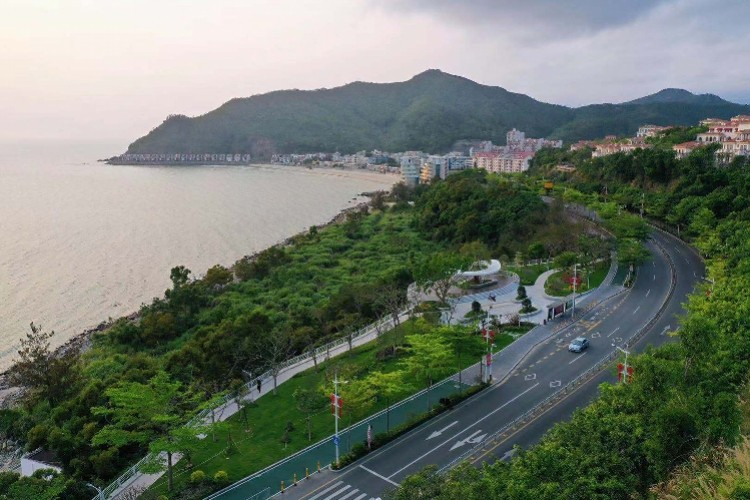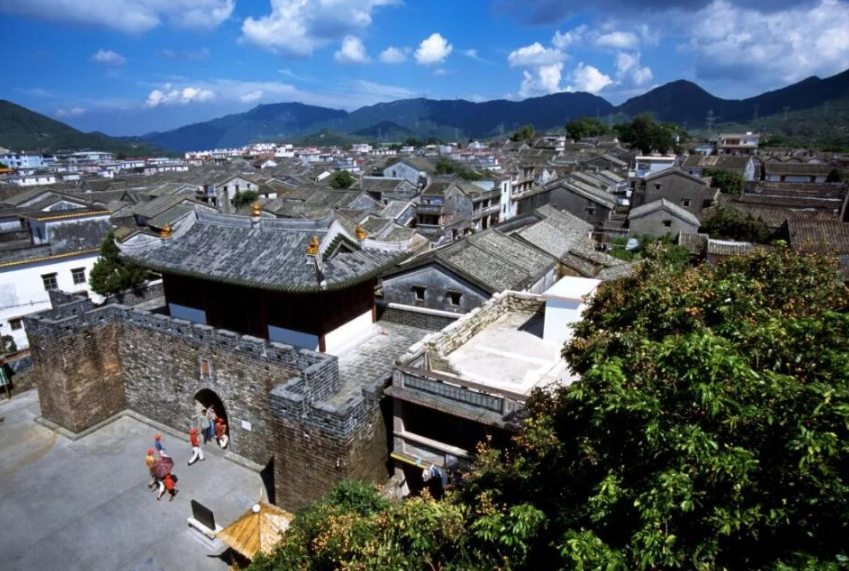
大鹏新区成立于2011年12月30日,是深圳经济特区中的生态特区 ,位于深圳东南部,三面环海,东临大亚湾,与惠州接壤,西抱大鹏湾,遥望香港新界,是粤港澳大湾区的重要节点。辖区面积600平方公里,其中陆域面积295平方公里,约占深圳市六分之一,海域面积305平方公里,约占深圳市四分之一,海岸线长133.22公里,约占全市的二分之一。共有28座水库,五个一级水源保护区水库水质为优,其中四个达到二级。下辖葵涌、大鹏、南澳三个办事处,25个社区,常住人口近20万,户籍人口3.9万。
海防文化、渔农文化、渔村文化、客家文化是新区典型的非物质文化遗产。新区现有不可移动文物点98处,具有地方特色的有价值村落共19个,其中半天云村被评为“广东省自然生态类最美乡村旅游示范点”。大鹏新区有深圳大鹏半岛国家地质公园、龙岩古寺、赖恩爵将军第、刘起龙将军墓、福田世居、长安世居、坝光村等景点。大鹏半岛森林覆盖率超过76%,整个大鹏半岛被称为深圳最后的“桃花源”,被《中国国家地理》评为“中国最美的八大海岸”之一。
交通配套

深圳东部快速干线盐坝高速公路贯穿与坪西一级公路在大鹏新区葵涌街道辖区内交汇,大鹏新区距陆路口岸沙头角和中国最大的深水港码头盐田港仅15分钟车程。
教育资源
2015年,大鹏新区拥有各类学校27所,比2014年增加2所。在校学生和专任教师分别为17023人和1058人。其中,小学6所,在校学生8327人;普通中学6所,在校学生3331人;幼儿园14间,在园儿童3678人。该区著名中学有:深圳亚迪学校、深圳市大鹏新区葵涌中学和深圳市大鹏新区华侨中学等。
著名景点

大鹏新区的著名景点有大鹏所城及深圳大鹏半岛国家地质公园。大鹏所城,始建于明洪武二十七年(公元1394年),占地约11万平方米,是明清两代中国南部的海防军事要塞,有着600多年抵御外侮的历史,涌现了赖思爵、刘起龙、刘黑仔等一批杰出的民族英雄。深圳今又名“鹏城”即源于此。大鹏所城是广东省重点文物保护单位和爱国主义教育基地。1995年,大鹏所城被定为“深圳市爱国主义教育基地”;2001年6月25日,大鹏所城被国务院公布为“全国重点文物保护单位”;2003年10月8日,大鹏所城所在的鹏城村被建设部和国家文物局公布为“中国历史文化名村”;2004年6月28日,大鹏所城被评为“深圳八景”之首。
深圳大鹏半岛国家地质公园位于深圳市东部、大鹏半岛中南部,与市区相距约50公里,公园地质遗迹保护面积50.87平方公里,森林覆盖率98%。所在的大鹏半岛东临大亚湾、与惠州接壤,西接大鹏湾,南濒中国南海,距离香港平洲最短距离两海里。
Dapeng New District was established on 30 December 2011 as an ecological special zone in the Shenzhen Special Economic Zone. Surrounded by sea on three sides, the new district is located in the southeastern part of Shenzhen, facing Daya Bay in the east, bordering Huizhou, holding Dapeng Bay in the west, looking out to Hong Kong New Territories, being an important node in the Guangdong-Hong Kong-Macau Greater Bay Area. The total area under its jurisdiction is 600 sq. km., of which the land area is 295 sq. km., accounting for one-sixth of Shenzhen. The sea area is 305 sq. km., accounting for one-quarter of Shenzhen, and the coastline is 133.22 km. long, accounting for approximately half of the city. There are a total of 28 reservoirs, and the water quality of the five first-class water source reserves is excellent, and four of them reach the second level. It has three offices in Kwai Chung, Dapeng and Nan'ao, 25 communities, a resident population of nearly 200,000 and a registered population of 39,000.
Typical intangible cultural heritage of Dapeng includes coastal defense culture, fisherman culture, fishing village culture, and Hakka culture. There are 98 non-removable cultural relic sites, and a total of 19 valuable villages with local characteristics. Among them, Bantianyun Village has been rated as "the most beautiful rural tourism demonstration site in Guangdong Province". Dapeng New District has Shenzhen Dapeng Peninsula National Geological Park, Longyan Ancient Temple, General Ryan's Residence, General Liu Qilong's Tomb, Futian Ancient House, Changan Ancient House, and Baguang Village. Forest coverage of Dapeng Peninsula is over 76%, which is known as the last "Peach Blossom Source" in Shenzhen, and has been rated as "one of the eight most beautiful coasts in China" by China National Geographic.
Transportation Facilities
Shenzhen’s eastern highway, Yanba Expressway, intersects with Pingxi First Class Highway at Kwai Chung Street in Dapeng. Dapeng New District is only 15 min. away from Shatoujiao Port, and the largest deepwater port in China, Yantian Port.
Educational Resources
In 2015, Dapeng New District had 27 schools of various types, an increase of 2 from 2014. Among them were 6 primary schools having 8,327 students, 6 ordinary middle schools having 3,331 students, and 14 kindergartens having 3,678 children. There were 17,023 students and 1,058 full-time teachers, respectively. Famous middle schools in the area include Shenzhen Yadi School, Shenzhen Dapeng Kwai Chung Middle School, and Shenzhen Dapeng Overseas Chinese Middle School.
Tourist Attractions
Popular tourist spots in Dapeng include Dapeng City and Shenzhen Dapeng Peninsula National Geological Park. Dapeng City was built in the 27th year of Ming Hongwu (AD 1394) covering an area of about 110,000 sq. m. With a history of more than 600 years, it was a coastal defence military fortress in southern China in the Ming and Qing dynasties, giving rise to a number of national heroes including Lai Sijue, Liu Qilong, and Liu Heizai. That’s the reason why Shenzhen is also known as "Pengcheng" today. Dapeng City is now a key cultural protection unit and patriotic education base in Guangdong Province. In 1995, Dapeng City was designated as "Shenzhen Patriotism Education Base". On 25 June 2001, it was declared by the State Council as a "National Key Cultural Relics Protection Unit". On 8 October 2003, Pengcheng Village, where Dapeng City is located, was announced by the Ministry of Construction and the State Administration of Cultural Heritage as a "China's Famous Historical and Cultural Village". On 28 June 2004, Dapeng City was named the first of "Shenzhen's Eight Scenic Spots". Shenzhen Dapeng Peninsula National Geological Park is located in the eastern part of Shenzhen, and the south-central part of Dapeng Peninsula. It is about 50 km. away from the urban area. The park has a protected area of 50.87 sq. km., and a forest coverage rate of 98%. Dapeng Peninsula is located on the east of Daya Bay, bordering Huizhou, on the west of Dapeng Bay and the south of the South China Sea, within a short distance of two sea miles from Ping Chau, Hong Kong.